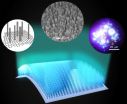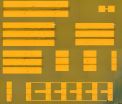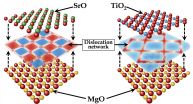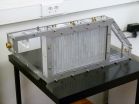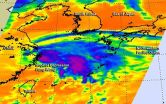(Press-News.org) VIDEO:
This is an animation of the micro-rod growth process.
Click here for more information.
WASHINGTON D.C., Sept. 23, 2014 -- "Bendy" light-emitting diode (LED) displays and solar cells crafted with inorganic compound semiconductor micro-rods are moving one step closer to reality, thanks to graphene and the work of a team of researchers in Korea.
Currently, most flexible electronics and optoelectronics devices are fabricated using organic materials. But inorganic compound semiconductors such as gallium nitride (GaN) can provide plenty of advantages over organic materials for use in these devices -- including superior optical, electrical and mechanical properties.
One major obstacle that has so far prevented the use of inorganic compound semiconductors in these types of applications was the difficulty of growing them on flexible substrates.
In the journal APL Materials, from AIP Publishing, a team of Seoul National University (SNU) researchers led by Professor Gyu-Chul Yi describes their work growing GaN micro-rods on graphene to create transferrable LEDs and enable the fabrication of bendable and stretchable devices.
"GaN microstructures and nanostructures are garnering attention within the research community as light-emitting devices because of their variable-color light emission and high-density integration properties," explained Yi. "When combined with graphene substrates, these microstructures also show excellent tolerance for mechanical deformation."
Why choose graphene for substrates? Ultrathin graphene films consist of weakly bonded layers of hexagonally arranged carbon atoms held together by strong covalent bonds. This makes graphene an ideal substrate "because it provides the desired flexibility with excellent mechanical strength -- and it's also chemically and physically stable at temperatures in excess of 1,000°C," said Yi.
It's important to note that for the GaN micro-rod growth, the very stable and inactive surface of graphene offers a small number of nucleation sites for GaN growth, which would enhance three-dimensional island growth of GaN micro-rods on graphene.
To create the actual GaN microstructure LEDs on the graphene substrates, the team uses a catalyst-free metal-organic chemical vapor deposition (MOCVD) process they developed back in 2002.
"Among the technique's key criteria, it's necessary to maintain high crystallinity, control over doping, formation of heterostructures and quantum structures, and vertically aligned growth onto underlying substrates," Yi says.
When the team put the bendability and reliability of GaN micro-rod LEDs fabricated on graphene to the test, they found that "the resulting flexible LEDs showed intense electroluminescence (EL) and were reliable -- there was no significant degradation in optical performance after 1,000 bending cycles," noted Kunook Chung, the article's lead author and a graduate student in SNU's Physics Department.
This represents a tremendous breakthrough for next-generation electronics and optoelectronics devices -- enabling the use of large-scale and low-cost manufacturing processes.
"By taking advantage of larger-sized graphene films, hybrid heterostructures can be used to fabricate various electronics and optoelectronics devices such as flexible and wearable LED displays for commercial use," said Yi.
INFORMATION:
The article, "Growth and characterizations of GaN micro-rods on graphene films for flexible light-emitting diodes," is authored by Kunook Chung, Hyeonjun Beak, Youngbin Tchoe, Hongseok Oh, Hyobin Yoo, Miyoung Kim, and Gyu-Chul Yi. It will appear in the journal APL Materials on September 23, 2014. After that date, it can be accessed at: http://scitation.aip.org/content/aip/journal/aplmater/2/9/10.1063/1.4894780
ABOUT THE JOURNAL
APL Materials is a new open access journal featuring original research on significant topical issues within the field of materials science. See: http://aplmaterials.aip.org
'Bendy' LEDs
Korean research team has grown gallium nitride micro-rods on graphene substrates to create transferrable light-emitting diodes -- enabling bendable optoelectronics devices.
2014-09-23
ELSE PRESS RELEASES FROM THIS DATE:
Diabetes: Complexity lost
2014-09-23
WASHINGTON, D.C., September 23, 2014 -- For millions of people in the United States living with Type 1 or Type 2 diabetes, measuring the daily rise and fall of blood glucose (sugar) is a way of life.
Our body's energy is primarily governed by glucose in the blood, and blood sugar itself is exquisitely controlled by a complicated set of network interactions involving cells, tissues, organs and hormones that have evolved to keep the glucose on a relatively even keel, pumping it up when it falls too low or knocking it down when it goes too high. This natural dynamical balance ...
Future flexible electronics based on carbon nanotubes
2014-09-23
WASHINGTON, D.C., September 23, 2014—Researchers from the University of Texas at Austin and Northwestern University have demonstrated a new method to improve the reliability and performance of transistors and circuits based on carbon nanotubes (CNT), a semiconductor material that has long been considered by scientists as one of the most promising successors to silicon for smaller, faster and cheaper electronic devices. The result appears in a new paper published in the journal Applied Physics Letters, from AIP Publishing.
In the paper, researchers examined the effect ...
Lack of sleep increases risk of failure in school
2014-09-23
A new Swedish study shows that adolescents who suffer from sleep disturbance or habitual short sleep duration are less likely to succeed academically compared to those who enjoy a good night's sleep. The results have recently been published in the journal Sleep Medicine.
In a new study involving more than 20,000 adolescents aged between 12 and 19 from Uppsala County, researchers from Uppsala University demonstrate that reports of sleep disturbance and habitual short sleep duration (less than 7 hours per day) increased the risk of failure in school.
The study was led ...
Moving to the 'burbs is bad for business
2014-09-23
This news release is available in French. Montreal, September 23, 2014 — It's rare to see a Wal-Mart downtown. Big box stores usually set up shop in the suburbs, where rent is cheap and the consumer base is growing. So should smaller stores follow suit?
Not so fast, says Concordia University professor Tieshan Li. His recent study, published in the Canadian Journal of Administrative Sciences, shows that higher profits are had by retailers located furthest from where the market is expanding.
"Those results may seem counterintuitive but the decreased profits are ...
Los Alamos researchers uncover properties in nanocomposite oxide ceramics for reactor fuel
2014-09-23
Nanocomposite oxide ceramics have potential uses as ferroelectrics, fast ion conductors, and nuclear fuels and for storing nuclear waste, generating a great deal of scientific interest on the structure, properties, and applications of these blended materials.
"The interfaces separating the different crystalline regions determine the transport, electrical, and radiation properties of the material as a whole," said Pratik Dholabhai, principal Los Alamos National Laboratory researcher on the project. "It is in the chemical makeup of these interfaces where we can improve ...
Beating stress outdoors? Nature group walks may improve mental health
2014-09-23
ANN ARBOR, Mich. — They are common suggestions to remedy stress: You just need a breath of fresh air. Walk it off. Get out and see people.
Turns out all those things combined may in fact make you feel better – a lot better – a new large scale study suggests.
Group nature walks are linked with significantly lower depression, less perceived stress and enhanced mental health and well-being, according to the study conducted by the University of Michigan, with partners from De Montfort University, James Hutton Institute, and Edge Hill University in the United Kingdom. The ...
Paraffins to cut energy consumption in homes
2014-09-23
Thermal energy storage is a common strategy in energy production systems in which the period of production does not coincide with that of consumption. This happens with the production of hot water by means of solar thermal panels, for example; here, hot water is produced during sunlight hours when demand is lower. It is also the case in residential cogeneration, where heat and electrical power are simultaneously generated but not so demand. In both cases, storing the heat allows production to be decoupled from demand, thus making the integration of these technologies into ...
Advancing the understanding of an understudied food allergy disorder
2014-09-23
Investigators at Cincinnati Children's Hospital Medical Center have published the first study to extensively characterize eosinophilic gastritis (EG). The study, published in The Journal of Allergy and Clinical Immunology, found that EG is a systemic disorder that has high levels of eosinophils in the blood and gastrointestinal tract, involves a series of allergy-associated-immune mechanisms and has a gene expression pattern (transcriptome) that is distinct from that of a related disorder, eosinophilic esophagitis (EoE).
Eosinophilic gastrointestinal disorders are chronic ...
Gene mutation discovered in blood disorder
2014-09-23
An international team of scientists has identified a gene mutation that causes aplastic anemia, a serious blood disorder in which the bone marrow fails to produce normal amounts of blood cells. Studying a family in which three generations had blood disorders, the researchers discovered a defect in a gene that regulates telomeres, chromosomal structures with crucial roles in normal cell function.
"Identifying this causal defect may help suggest future molecular-based treatments that bypass the gene defect and restore blood cell production," said study co-leader Hakon Hakonarson, ...
NASA sees Tropical Depression Fung-Wong becoming more frontal
2014-09-23
Tropical Depression Fung-Wong skirted the coast of mainland China and is moving through the East China Sea. NASA's Aqua satellite captured cloud top temperature data that showed strongest thunderstorms were stretched out as the storm continues to look more frontal in nature.
When NASA's Aqua satellite passed over Fung-Wong on Sept. 22 at 1:23 p.m. EDT, the Atmospheric Infrared Sounder or AIRS instrument read cloud top temperatures. AIRS detected strongest, highest storms, those with the coldest cloud tops stretched out from northwest to southeast giving the depression ...
LAST 30 PRESS RELEASES:
Heart-brain connection: international study reveals the role of the vagus nerve in keeping the heart young
Researchers identify Rb1 as a predictive biomarker for a new therapeutic strategy in some breast cancers
Survey reveals ethical gaps slowing AI adoption in pediatric surgery
Stimulant ADHD medications work differently than thought
AI overestimates how smart people are, according to HSE economists
HSE researchers create genome-wide map of quadruplexes
Scientists boost cell "powerhouses" to burn more calories
Automatic label checking: The missing step in making reliable medical AI
Low daily alcohol intake linked to 50% heightened mouth cancer risk in India
American Meteorological Society announces Rick Spinrad as 2026 President-Elect
Biomass-based carbon capture spotlighted in newly released global climate webinar recording
Illuminating invisible nano pollutants: advanced bioimaging tracks the full journey of emerging nanoscale contaminants in living systems
How does age affect recovery from spinal cord injury?
Novel AI tool offers prognosis for patients with head and neck cancer
Fathers’ microplastic exposure tied to their children’s metabolic problems
Research validates laboratory model for studying high-grade serous ovarian cancer
SIR 2026 delivers transformative breakthroughs in minimally invasive medicine to improve patient care
Stem Cell Reports most downloaded papers of 2025 highlight the breadth and impact of stem cell research
Oxford-led study estimates NHS spends around 3% of its primary and secondary care budget on the health impacts of heat and cold in England
A researcher’s long quest leads to a smart composite breakthrough
Urban wild bees act as “microbial sensors” of city health.
New study finds where you live affects recovery after a hip fracture
Forecasting the impact of fully automated vehicle adoption on US road traffic injuries
Alcohol-related hospitalizations from 2016 to 2022
Semaglutide and hospitalizations in patients with obesity and established cardiovascular disease
Researchers ‘listen in’ to embryo-mother interactions during implantation using a culture system replicating the womb lining
How changing your diet could help save the world
How to make AI truly scalable and reliable for real-time traffic assignment?
Beyond fragmented markets: A new framework for efficient and stable ride-pooling
Can shape priors make road perception more reliable for autonomous driving?
[Press-News.org] 'Bendy' LEDsKorean research team has grown gallium nitride micro-rods on graphene substrates to create transferrable light-emitting diodes -- enabling bendable optoelectronics devices.

